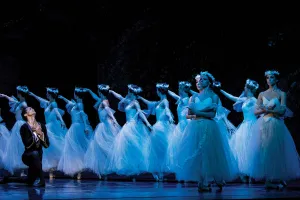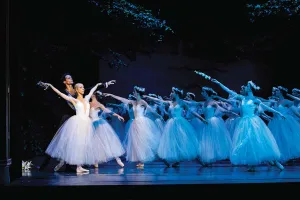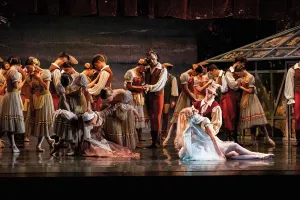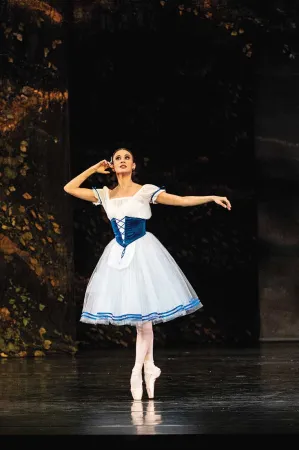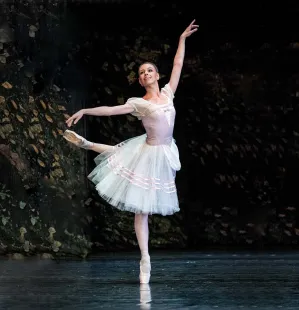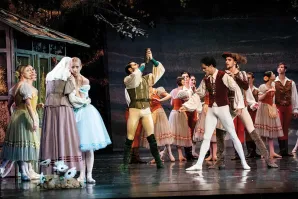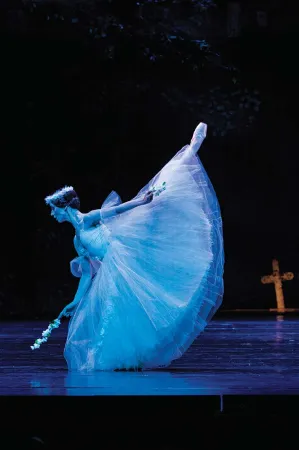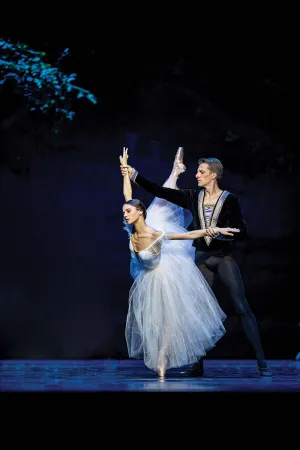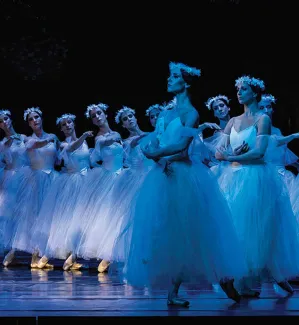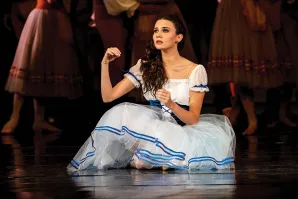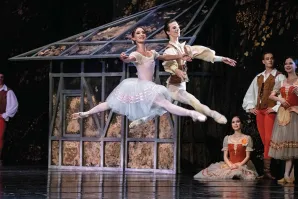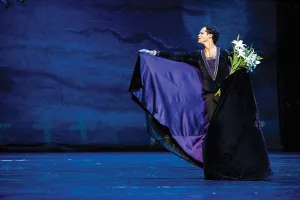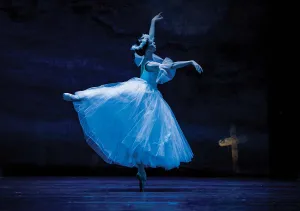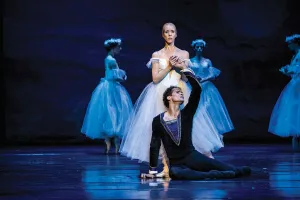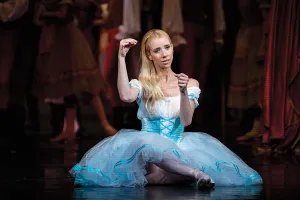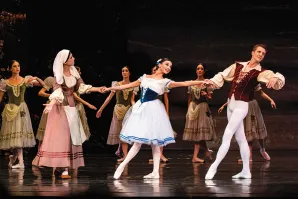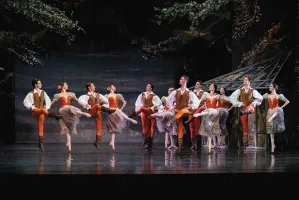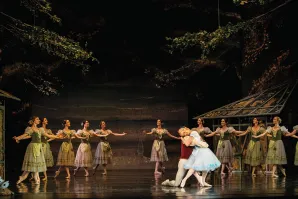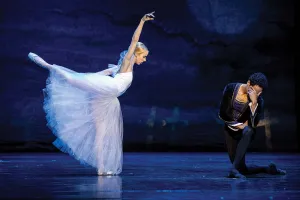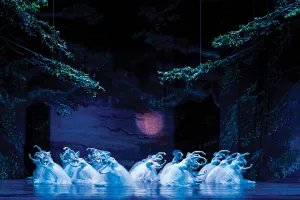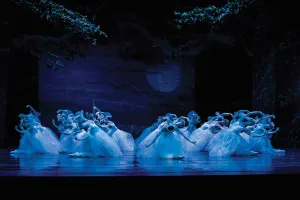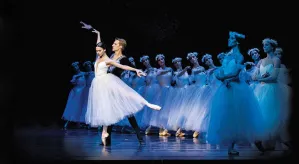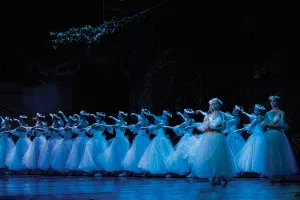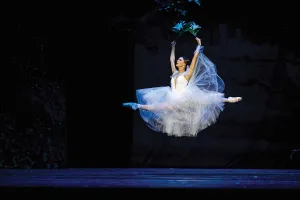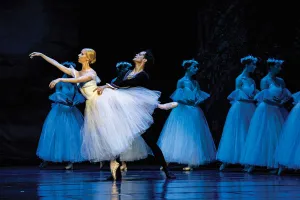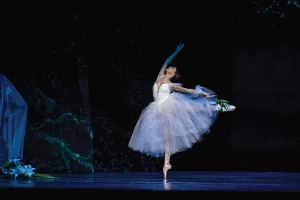Giselle
ballet by Adolph Adam
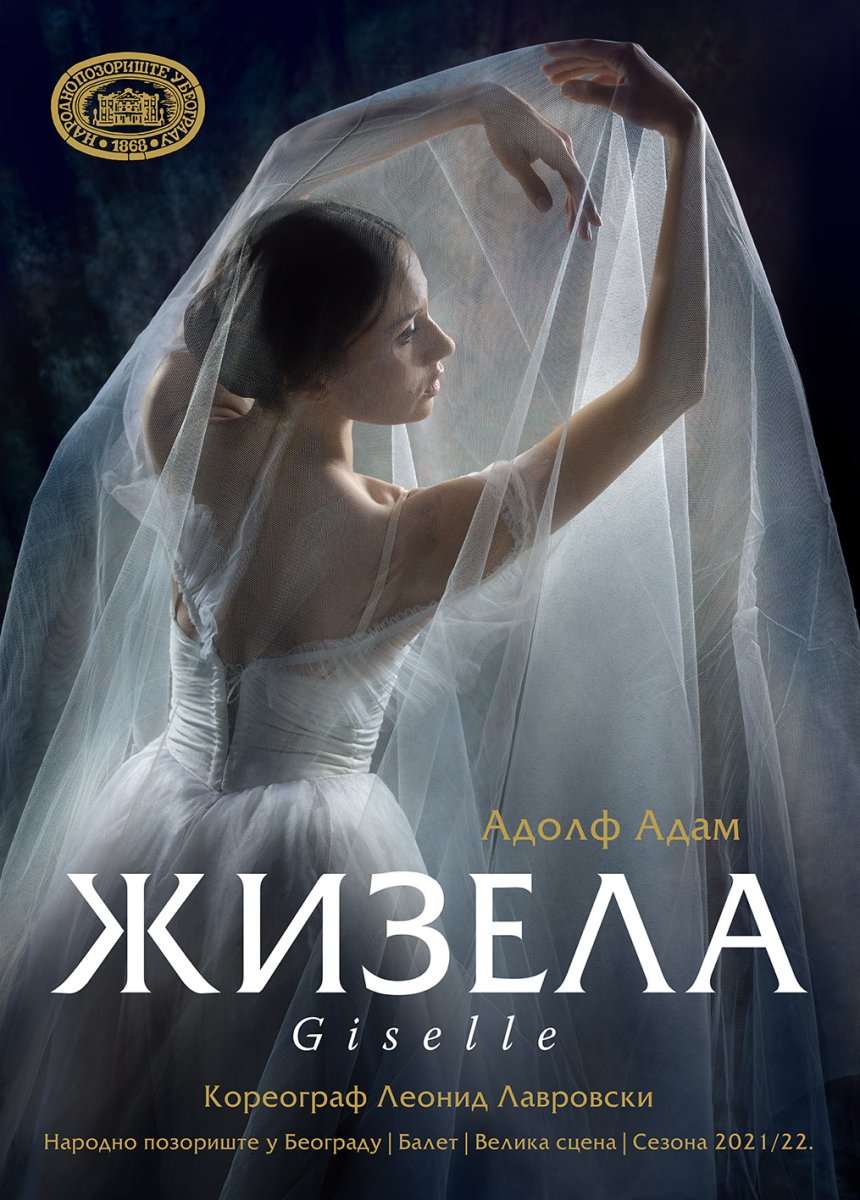
GISELLE - PURE BEAUTY OF THE WHITE BALLET
Giselle, the most poetic ballet of the Romantic era, also known as The Wilis, is a constant subject of research and analysis whose goal is to answer the question - what is the secret of immortality and the timeless dimension of this true gem of the White Ballet? One of the reasons can be probably found in the fantastic music of the composer Adolphe Adam, who himself stressed his ambition to make music for stage performances that is clear and interesting to the audience. Inspired by a simple and yet precise libretto, he created music which is light, likable, melodious, and with unobtrusive orchestrations. In search of the libretto, the writer Théophile Gautier finds the main motif in a poem by Victor Hugo, Phantoms, as well as in an old Rhine legend adapted by the German poet Heinrich Heine in his work De L’Allemagne. It is also known that Heine was very inspired by Serbian folk poetry, and the Slavic legend speaks of girls who, if they die on their wedding day, become fairies (wilis), airy, disembodied beings. They rise from their graves, and drag anyone who sees them at that moment into an ecstatic dance to exhaustion and, finally, death. Theophile Gauthier’s idea was accepted by Jules-Henri Vernoy de Saint-Georges, a French playwright, one of the most prominent librettists of the 19th century, and thus a famous story was told that in a simple way speaks of sincere love as the culmination of the ideal of romanticism. The quality of the Giselle libretto was also emphasized by Akim Volinsky, a famous ballet critic. Choreographer Jean Coralli worked diligently on the ballet production, and his intelligent and well-designed choreographic basis contributed to Giselle’s success on stages around the world for over one hundred and eighty years. The premiere took place at the famous Paris Opera (Académie Royale de Musique) on June 28, 1841, and the main roles were played by Carlotta Grisi, Lucien Petipa and Adèle Dumilâtre. It is believed that Jules-Joseph Perrot, a renowned choreographer and husband of Carlotta Grisi, also participated in the creation of the play and contributed to its great success, but there is no material evidence for that, and his name was not signed on the premiere poster. Although the ballet was very successful and was a sensation, Giselle simply disappeared from the repertoire of the Paris Opera in 1868.
A triumphant return to the Parisian stage took place in 1910, thanks to Sergei Diaghilev, the famous Russian patron of the arts and ballet impresario. The Mariinsky Theatre from Petrograd (today’s St. Petersburg) took over Giselle, where it is preserved in its original form to this day. Marius Petipa, a celebrated French choreographer, the founder of classical ballet academism, who insisted on strict form and complex dance of ensembles and soloists, can be certainly given credit for that. In addition to the new ballets he composed, following current events in the world, Petipa started the trend of renewal, but also new productions of older ballets. His editions are strictly related to certain artistic principles that we recognize in most of the titles of the ballet in Romanticism. Thus, he laid the foundations of the historical repertoire and ensured the continuous performance of ballets such as Giselle or La Corsaire. The ballets of the Romantic era have survived to this day, probably thanks to the fact that they were adapted or refined in accordance with the current moment.
The ballet Giselle is both classical and romantic. When we call it a classic, then we do not refer to a certain historical or stylistic category, but to the significance of the work whose value is widely recognized and timeless. Giselle became the main feature of the White Ballet and established this term. This is especially pronounced in the second act, when ballerinas in virgin white, airy costumes conquer the stage and represent the classic style - academic style of classical ballet (danse d`ecole). Also, the new academic dance brings the dominance of women on the stage, especially expressed in dancing on the toe tips, which becomes a metaphor of femininity. Giselle survives in the modern world, and captivates the audience with its unusual vision that from a real, human story, full of emotions, joy of play, chaste love in the first act goes to betrayal, madness and, finally, death only to take us into the second act with ethereal fairy dance, pure beauty of the White Ballet and, finally, we witness the triumph of love that is stronger than death itself.
Brankica Knežević
An excerpt from the text: Giselle – The Pure Beauty of the White Ballet, Teatron 184/185, MPUS, 2018
GISELLE ON THE NATIONAL THEATRE STAGE
The premiere of the ballet Giselle at the National Theatre was held on April 24, 1926, choreographed by Aleksandar Fortunato, with Nina Kirsanova in the title role. The next premiere took place in 1931, choreographed by Nina Kirsanova, who again played the lead role. She renewed Giselle on our stage once again, in 1939. At that time, she performed only at the premiere, and the first Serbian ballerina, Nataša Bošković, continued to play the title role with great success. The artists who interpreted the role of Giselle in this period were Jelena Poliakova, Margarita Froman and Marina Olenina. By the beginning of World War II, Giselle had been performed forty times. After the horrible and poignant war and difficult post-war years, Giselle returned to the stage where it would achieve great success in the choreography of the famous Russian player and choreographer Leonid Lavrovsky. Lavrovsky’s choreographic version is considered the purest one and was performed by important ballet companies such as the Bolshoi Theatre, the Mariinsky Ballet and the Paris Opera. The National Theatre Ballet also joined this quite distinguished company when on April 14, 1957 Giselle premiered on this Theatre stage, in choreography of Leonid Lavrovsky. This choreographic version relied on Perrot and Coralli and was extremely well directed and psychologically nuanced in detail. The title role was played by the then very young soloist Duška Sifnios, Albrecht by Stevan Grebeldinger, and Myrtha, the Queen of Wilis by Vera Kostić. Art critics wrote about the play in superlatives, and especially praised the fantastic interpretation of Duška Sifnios, who played the role of Giselle one hundred and seventy-seven times during her career. The audience and critics followed Giselle with great delight until the last performance in 1985.
The premiere of Giselle in the version that is still performed today, was held on June 27, 1991, and the choreographic version of Leonid Lavrovsky was executed by prima ballerina and ballet master Katarina Obradović. Her artistic development is inextricably linked to the National Theatre as she was among the first ballet artists to perform on our stage after the Second World War. With great dedication and responsibility, she conveyed Lavrovsky’s choreographic idea, with whom she personally collaborated, and she constantly emphasized the importance and immortality of this great romantic ballet and tried to preserve the authentic version until the very end.
The special significance of Giselle lies in the fact that this performance launched to stardom a large number of our ballet artists. The role of Giselle was interpreted by: Katarina Obradović, Jovanka Bjegojević, Višnja Đorđević, Dušica Tomić, Jelena Šantić, Ivanka Lukateli, Ljiljana Šaranović, Milica Bijelić, Duška Dragičević, Ašhen Ataljanc, Ana Pavlović, Mila Dragičević and Dalija Imanić.
The role of Albrecht was played by: Dušan Trninić, Žarko Prebil, Borivoje Mladenović, Radomir Vučić, Aleksandar Izrailovski, Dušan Simić, Ranko Tomanović, Konstantin Kostyukov, Konstantin Tešea, Denis Kasatkin, Jovan Veselinović, Jovica Begojev and Dejan Kolarov.
Brankica Knežević
An excerpt from the text: Giselle - The Pure Beauty of the White Ballet, Teatron 184/185, MPUS, 2018
LIBRETTO
Act one
A vine festivity takes place in the village. Giselle, a country girl, falls in love with Loys, without realizing that he is a disguised nobleman, prince Albrecht, Duke of Silesia. The dance of two lovebirds is interrupted by Hilarion the forester, who pursues Giselle’s affection as well. She declines his love and he leaves embittered.
Everybody dances. Mother scolds Giselle for dancing, because it’s too strenuous effort for her weak heart. She reminds her that according to a legend, if she died before her wedding, she would enter land of Willis. Duke of Courlande followed by his hunting escort, stops in front of Giselle’s house. The daughter of the Duke, Bathilde, impressed with Giselle’s beauty and kindness bestows on her a priceless neckless.
Forester Hilarion brings in a silver sward with coat of arms which belongs to prince Albrecht. Thus Hilarion’s suspicion concerning Albrecht’s deception becomes true. He discloses Albrecht’s duplicity before the Duke, his daughter, his escort and the countrymen. Giselle finds out that princess Bathilde is Albrecht’s fiancee.
Cheated of her last hope, she realizes that the entire world of her dreams falls apart. Only a distant memory of her forsaken love remains. She loses her mind and dies.
Act Two
At the graveyard by the lake Giselle’s tombstone is lit by the moon. Driven by his guilty conscience, Hilarion comes to Giselle’s tombstone. White shadows pass him by. These are Willis, the spirits of abandoned girls who had died before they wedded. They took revenge on young men, by forcing them into a dance to death. Myrtha, the queen of Willis, orders them to take Hilarion’s life. She rises Giselle from her grave and calls her to join the world of Willis; Giselle appears covered with a white veil.
Prince Albrecht can’t forget Gisellle and he comes to visit her tombstone. All of a sudden, he sees the apparition of his beloved Gisellle . Merciless Myrtha condemns him to dancing the Willis’ dance of death. Eventually, exhausted Albrecht falls down, being convinced that his last hour has come. The bells announce a new dawning. White shadows flee. Giselle’s spirit also vanishes. Albrecht stays all alone. The power of eternal love has saved him.
(Translated by Nataša Mojsilović)
Premiere performance
Premiere, 27th June 1991
Main Stage
Romantic ballet in two acts
Libretto T. Gautier, V. Saint Georges and J. Coralli
Choreography Leonid Lavrovski after J. Coralli, J. Perrot, M. Petipa
Realisation Katarina Obradović
Sets Boris Maksimović
Costumes Božana Jovanović
Conductor Angel Šurev
Premiere Cast:
Giselle Milica Bjelić
Albrecht Ranko Tomanović
Hilarion Stevan Hadži Slavković
Bathilde, Albrecht ’s fiancée Nadežda Šarić
The Prince of Courland Ratko Petrović
Wilfred Aleksandar Šmit
Giselle’s Mother Violeta Milošević
Myrtha Ašhen Ataljanc
Wilis Milica Antić, Marija Vještica
Pas de deux Gordana Simić, Saša Adamović
Giselle’s Friends Milica Antić, Marija Vještica, Marija Milanović, Tatjana Ninković, Kosovka Radić, Ružica Selenić
Waltz I Act T. Antonijević, G. Glođajić, S. Žugić, S. Marković, M. Milanović, J. Paunović, T. Popović, Lj. Rajković, M. Radojčić, V. Rančić, L. Tolnai, Z. Šišović
Peasants’ Dance T. Antonijević, G. Glođajić, M. Kecman, P. Musić Popović, Lj. Rajković, V. Rančić, D. Stanojević, Z. Šišović, Lj. Vučić, M. Dujaković, M. Klenču, J. Mitrović, S. Mihić, R. Nedić, Lj. Nikolić. N. Stanković
Wilis II Act T. Antonijević, G. Glođajić, A. Đaković, I. Živković Sultanović, S. Žugić, R. Kuzmanović, S. Marković, M. Milanović, T. Ninković, A. Pavlović, J. Paunović, T. Popović, Lj. Rajković, M. Radojčić, V. Rančić, R. Selenić, L. Tolnai, Z. Šišović, M. Dragičević
Ladies and Gentlemen D. Bjelica, D. Erdeljan, I. Stanišić, R. Grujičić, N. Radojković, B. Tojagić
With participation of the Orchestra of the Opera
Ballet Associates Višnja Đorđević, Botir Ohundedajev
Organisers Slobodanka Popović i Borivoj Marković
Set Design Realized by Aleksandar Nikolić
Music Associates Gorjan Korunoski, Marija Mazur, Dušan Maksimović
Concertmasters Stojan Grbić, Balint Varga
Design of the Playbill and front page of the Programme Geroslav Zarić
Assistant Choreographer Dragana Bojić Nikolić, Zora Mojsilović
Sculpting Stanimir Pavlović
Set crew Chief Mile Radulović
Light Operator Petar Alagić
Make-Up Memiš Nijaz
Stage Manager Mirjana Goločevac

